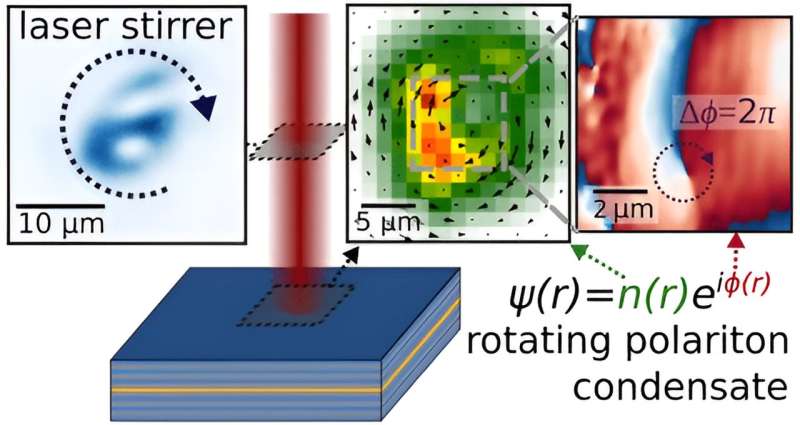By using a special combination of laser beams as a very fast stirrer, RIKEN physicists have created multiple vortices in a quantum photonic system and tracked their evolution. This system could be used to explore exotic new physics related to the emergence of quantum states from vortex matter. The research is published in the journal Nano Letters.
In principle, if you were to swim in a pool filled with a superfluid, a single stroke would be all you need to swim an infinite number of laps. That’s because, unlike normal fluids like water, superfluids have no resistance to motion below a certain velocity.
Superfluids also behave weirdly when stirred. “If you stir a bucket of water, you typically get just one big vortex,” explains Michael Fraser of the RIKEN Center for Emergent Matter Science. “But when you rotate a superfluid, you initially create one vortex. And when you rotate it faster, you get progressively more and more vortices of precisely the same size.”
While also seen in liquid helium and atomic systems, a form of superfluidity is displayed by a system made up of particle-like entities known as polaritons, in which a photon of light couples strongly with a negative electron bound to a positive hole in a semiconductor. Researchers want to “stir” such systems, but this is challenging since it requires using extremely high frequencies—millions of times faster than those needed for atomic systems.
Now, Fraser and co-workers have used a specially crafted laser beam to incoherently stir such a polariton condensate, creating ensembles of vortices.
“These condensates have been around for more than 15 years, and a lot of interesting physics has been done with them,” says Fraser. “But rotation of a polariton superfluid causing multiple vortices to collect and freely evolve had not been achieved before.”
The team created their special laser beam stirrer by combining a regular laser beam with one that had a donut-like shape. The frequencies of the two beams were slightly off, and this frequency difference matched the frequency needed to rotate polaritons. Using this beam, the researchers could control their speed and direction of rotation, and create vortices at will. They even showed that the faster the rotation, the more vortices could be captured close to the rotation axis.
Furthermore, the experimental measurements they obtained agreed well with simulations based on theory.
“Our rotation scheme thus allows the study of self-ordering vortex dynamics in an open-dissipative platform—one that continually loses and gains particles,” explains Fraser. “This is especially exciting as not only do we expect it to exhibit new vortex phenomena, but it also opens up opportunities to study highly quantum, topological phases of light.”


